当前位置:
X-MOL 学术
›
Phys. Rev. Fluids
›
论文详情
Our official English website, www.x-mol.net, welcomes your
feedback! (Note: you will need to create a separate account there.)
Acoustic wave propagation at nonadiabatic conditions: The continuum limit of a thin acoustic layer
Physical Review Fluids ( IF 2.5 ) Pub Date : 2020-03-04 , DOI: 10.1103/physrevfluids.5.033401 Y. Ben-Ami , A. Manela
Physical Review Fluids ( IF 2.5 ) Pub Date : 2020-03-04 , DOI: 10.1103/physrevfluids.5.033401 Y. Ben-Ami , A. Manela

|
Existing works on sound propagation in rarefied gases have focused on wave transmission at adiabatic conditions, where a reference uniform equilibrium state prevails. To extend these studies, we analyze the propagation of acoustic waves in a slightly rarefied gas at nonadiabatic conditions, where arbitrarily large reference temperature and density gradients are imposed. Considering a planar slab configuration, constant wall heating is applied at the confining walls to maintain the nonuniform reference thermodynamic distributions. Acoustic excitation is then enforced via small-amplitude harmonic wall oscillations and normal heat-flux perturbations. Focusing on continuum-limit conditions of small Knudsen numbers and high actuation frequencies (yet small compared with the mean collision frequency), the gas domain affected by wall excitation is confined to a thin layer (termed “acoustic layer”) in the vicinity of the excited boundary, and an approximate solution is derived based on asymptotic expansion of the acoustic fields. The application of thermoacoustic wall excitation necessitates the formation of an ever thinner “thermal layer” that governs the transmission of the wall's unsteady heat flux into sound waves. The results of the approximate analysis, supported by continuum-model finite differences and direct simulation Monte Carlo calculations, clarify the impacts of system nonadiabaticity and the gas kinetic model of interaction on sound propagation. Primarily, reference wall heating results in an extension of the acoustic layer and consequent sound-wave radiation over larger distances from the wall source. Considering the entire range of inverse power law (repulsion point center) interactions, it is also found that wave attenuation is affected by the kinetic model of gas collisions, yielding stronger decay rates in gases with softer molecular interactions. The results are used to generalize the counterpart adiabatic-system findings for the amount of boundary heat flux required for the silencing of vibroacoustic sound at nonadiabatic reference conditions.
中文翻译:

非绝热条件下的声波传播:薄声层的连续极限
现有的关于在稀有气体中传播声音的工作集中于绝热条件下的波传播,在该条件下,参考统一的平衡态占主导地位。为了扩展这些研究,我们在非绝热条件下分析了声波在稍微稀薄的气体中的传播,在非绝热条件下,施加了任意大的参考温度和密度梯度。考虑到平面平板的构造,在限制壁处施加恒定的壁加热以维持不均匀的参考热力学分布。然后通过小振幅谐波壁振荡和正常的热通量扰动来强制进行声激励。着眼于小Knudsen数和高致动频率(但与平均碰撞频率相比仍较小)的连续极限条件,受壁激励影响的气域被限制在受激边界附近的薄层(称为“声层”)中,并基于声场的渐近扩展得出近似解。热声壁激发的应用需要形成越来越薄的“热层”,该“热层”控制着壁的不稳定热通量向声波的传输。在连续模型有限差分和直接模拟蒙特卡洛计算的支持下,近似分析的结果阐明了系统非绝热性和相互作用的气体动力学模型对声音传播的影响。首先,参考壁加热会导致声学层的延伸,并导致声波辐射在距壁源更大的距离上产生。考虑到整个逆功率定律(排斥点中心)相互作用的整个范围,还发现波衰减受气体碰撞动力学模型的影响,在分子相互作用较弱的气体中产生更强的衰减率。该结果用于概括绝热系统的对应结果,以得出在非绝热参考条件下使声声消音所需的边界热通量。
更新日期:2020-03-04
中文翻译:

非绝热条件下的声波传播:薄声层的连续极限
现有的关于在稀有气体中传播声音的工作集中于绝热条件下的波传播,在该条件下,参考统一的平衡态占主导地位。为了扩展这些研究,我们在非绝热条件下分析了声波在稍微稀薄的气体中的传播,在非绝热条件下,施加了任意大的参考温度和密度梯度。考虑到平面平板的构造,在限制壁处施加恒定的壁加热以维持不均匀的参考热力学分布。然后通过小振幅谐波壁振荡和正常的热通量扰动来强制进行声激励。着眼于小Knudsen数和高致动频率(但与平均碰撞频率相比仍较小)的连续极限条件,受壁激励影响的气域被限制在受激边界附近的薄层(称为“声层”)中,并基于声场的渐近扩展得出近似解。热声壁激发的应用需要形成越来越薄的“热层”,该“热层”控制着壁的不稳定热通量向声波的传输。在连续模型有限差分和直接模拟蒙特卡洛计算的支持下,近似分析的结果阐明了系统非绝热性和相互作用的气体动力学模型对声音传播的影响。首先,参考壁加热会导致声学层的延伸,并导致声波辐射在距壁源更大的距离上产生。考虑到整个逆功率定律(排斥点中心)相互作用的整个范围,还发现波衰减受气体碰撞动力学模型的影响,在分子相互作用较弱的气体中产生更强的衰减率。该结果用于概括绝热系统的对应结果,以得出在非绝热参考条件下使声声消音所需的边界热通量。











































 京公网安备 11010802027423号
京公网安备 11010802027423号